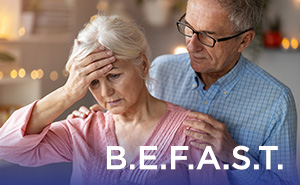When it Comes to Spotting a Stroke, B.E.F.A.S.T.
- Category: General, Emergency & Trauma, Neurology/Neurosurgery, Patients & Visitors, Primary Care, Rehabilitation
- Posted On:
- Written By: Boulder Community Health

May is National Stroke Awareness Month — A Good Time to Review the Warning Signs of a Stroke and Learn to B.E.F.A.S.T.!
Did you know? Most strokes are preventable. And a large percentage of the ones that happen are treatable with the right care, right away. It's a matter of knowing what to do, taking action and spreading the word.
Use the acronym B.E.F.A.S.T. for recognizing a stroke:
B - Balance: Watch for sudden loss of balance
E - Eyes: Check for vision loss
F - Face: Look for an uneven smile
A - Arm: Check if one arm is weak
S - Speech: Listen for slurred speech
T - Time: Call 9-1-1 right away
Stroke Facts
- Nearly 800,000 people in the United States have a stroke every year, with about three in four being first-time stroke sufferers.
- Someone in the United States has a stroke every 40 seconds, and every four minutes someone dies of stroke.
- On average, someone dies of a stroke every 3 minutes and 33 seconds in the U.S.
- 87% of strokes are classified as ischemic. An ischemic stroke occurs when a clot or a mass blocks a blood vessel, cutting off blood flow to a part of the brain.
- Stroke is a leading cause of long-term disability and the leading preventable cause of disability.
- When it comes to stroke, time matters. Your immediate action can help prevent brain damage and long-term disability.
What is a Stroke?
A stroke occurs when a blood vessel to a part of the brain becomes clogged or bursts. When this occurs, the nerve cells in that part of the brain can no longer work the right way. Every part of the brain controls a specific part of the body. The part of the brain that is affected by the blockage or bleeding will determine what deficits appear (for example, trouble speaking, walking or numbness and weakness).Primary Stroke Center
BCH has been awarded Advanced Certification as a Primary Stroke Center by The Joint Commission and the American Heart Association/American Stroke Association. These means we offer the latest in emergency treatments and diagnostic technology and have specially trained nurses and rehabilitation therapists to support stroke patients. Our program includes:
- Quick access to neurologists. Patients who arrive at our emergency department with signs of a stroke will be seen by a BCH neurologist, without waiting to be admitted to the hospital.
- Expedited care through Stroke Alert Protocol. Paramedics begin care in the ambulance and alert our stroke-care team so patients receive immediate treatment upon arrival at our Emergency Department.
- Specialized inpatient care. During your hospital stay, an experienced neurologist will direct your care and work closely with skilled nurses who have received extra stroke care education.
- Access to a caring support network. BCH holds free monthly support group meetings for stroke patients.
If you or someone you know is having a stroke, please call 9-1-1.
